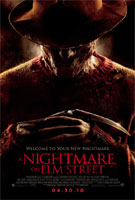Since 2003, Michael Bay’s production company Platinum Dunes has made seven films. Of those seven, five have been remakes of some of the most classic horror films ever made, ranging from The Texas Chainsaw Massacre to The Hitcher, the general consensus is typically a question: why did they bother? Now the company has put out their eighth film and sixth remake, this time tackling the legendary Wes Craven film A Nightmare on Elm Street, and, surprise, surprise, it is just as pointless as the others.
Unless you have ignored every bit of horror film history since 1984, you know the plot. Teenagers in the small town of Springwood, Ohio (Rooney Mara, Kyle Gallner, Katie Cassidy and Thomas Dekker) have begun to have the same nightmares about a burned man who wears knives on his fingers (Jackie Earle-Haley). Only these aren’t normal dreams; whatever happens to them in the dream world happens in real life and it appears that the mysterious man wants to kill them one by one. Desperately trying to stay awake and fighting their body’s natural needs, the teens must find a way to stop him before he kills them all.
Having previously earned an Oscar nomination for his role as a child molester in Little Children, Earle Haley played the legendary horror creation with an extra dose of creepy, no longer the jokester that he turned into in the sequels, but, at the same time, doesn’t divert greatly for the source material. What was he really supposed to do with the character that Robert Englund spent the last 26 years creating? He strays too far from the original character and he pisses off the die hard fans or he mimics the performance and gets ridiculed for a lack of originality. This double edged sword must have been taken into consideration prior to accepting the role, so the question remains why he took it. The voice he used, very similar to the one used for Rorschach in Watchmen and works effectively enough, but it could really have been anyone underneath the prothstetics and make-up and it really wouldn’t have made a difference.
As inevitably useless this re-hashing was, there was one thing that director Samuel Bayer could have done to give the idea a basis in reason, and that would be using updated technology to enhance both the dream world and Freddy Krueger’s abilities within it. Did they at least accomplish this small task? Not even remotely. The closest they get to warping reality is having condensation run up the side of a glass instead of down and Krueger can teleport, but not much more. Even scenes taken directly from the original, such as the classic “throwing around the room” scene and Freddy pressing through the wall above Nancy’s bed looked the same if not better in the 1984 film.
One credit that I will give the film is, just like the original, it toys with the audience’s understanding of what is real and what is in Freddy’s control, but it is done so formulaically that by late in the film, no matter how normal everything looks, you know that someone has drifted off to la-la land. From the very first scene it goes: 1) character is acting normal in a normal environment, 2) character begins to explore presumed normal environment, 3) character begins to slowly notice something is off, 4) Freddy shows up and shows off his claws, 4) character is startled awake. It’s as though Bayer didn’t have the attention span to let things build and the longest interaction with Krueger in the first half of the film couldn’t be more than 10 seconds. That’s not how you treat one of the greatest villains of all time.
The reality is that there is nothing here for anyone that has seen (and not even necessarily liked) Wes Craven’s masterpiece. Bayer tries to placate these people by remaking scenes shot-for-shot, but, as we learned with Gus Van Sant’s Psycho, this can be just as much an insult as the concept of remaking it in the first place. Helping create the slasher genre back in the 80s and still holding up in both scares and quality today, Wes Craven’s film is a quintessential horror classic. This remake is simply worthless.

Eric Eisenberg is the Assistant Managing Editor at CinemaBlend. After graduating Boston University and earning a bachelor’s degree in journalism, he took a part-time job as a staff writer for CinemaBlend, and after six months was offered the opportunity to move to Los Angeles and take on a newly created West Coast Editor position. Over a decade later, he's continuing to advance his interests and expertise. In addition to conducting filmmaker interviews and contributing to the news and feature content of the site, Eric also oversees the Movie Reviews section, writes the the weekend box office report (published Sundays), and is the site's resident Stephen King expert. He has two King-related columns.











